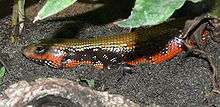Fire skink
The fire skink (Mochlus fernandi), also known as the true fire skink or Togo fire skink, is a fairly large skink, a species of lizard in the family Scincidae. The species is known for its bright and vivid coloration. Native to tropical forests in Western Africa, the fire skink lives fifteen to twenty years. This species is a diurnal lizard that loves to burrow and hide. It is relatively shy and reclusive, but may become tame in captivity.
| Fire skink | |
|---|---|
 | |
| Scientific classification | |
| Kingdom: | Animalia |
| Phylum: | Chordata |
| Class: | Reptilia |
| Order: | Squamata |
| Family: | Scincidae |
| Genus: | Mochlus |
| Species: | M. fernandi |
| Binomial name | |
| Mochlus fernandi (Burton, 1836) | |
| Synonyms[1] | |
Etymology
The specific name, fernandi, refers to the island formerly known as Fernando Po,[2] which has been called Bioko since 1979. It is known in the Yoruba language, spoken in Western Africa, as Ọlọyọmbẹ́rẹ́.
Taxonomy
Historically, the fire skink has been placed in several different genera and was until recently placed in Riopa together with several skinks from southeast Asia. While these are superficially similar to the African fire skink, they are closer to some other Asian skinks, resulting in their move to Mochlus. The fire skink is not closely related to other skinks and belongs to the genus Mochlus.[3] However, a review of the taxonomy of the fire skink did reveal that it, as traditionally defined, actually consists of three separate species. This essentially limits true M. fernandi to tropical Western Africa, while population in Central and East Africa are M. hinkeli and M. striatus.[3]
Description
The fire skink is a fairly large species of skink, reaching up to 37 cm (15 in) in total length (including tail).[1] The most notable aspect of the fire skink's appearance is its vivid, bright colors. Smooth, gold scales adorn the fire skink's back, while red and black bars set against a silver background line its sides. The fire skink does not display obvious sexual dimorphism, which makes it difficult to sex. Males are, in general, bulkier than females with a slightly flatter head and wider jaws.[4]
Reproduction
The fire skink, unlike many other skink species, is oviparous. An adult female will generally lay a clutch of five to nine eggs after mating. Fire skink eggs take forty to fifty days to hatch when incubated at a temperature of 85 °F (29 °C).
Diet
M. fernandi has a large appetite, and it is mainly insectivorous. Insects such as crickets, and larvae such as mealworms, are used for feeding captive specimens.[4]
In captivity
The fire skink is kept as a pet. Many specimens available for sale are wild-caught, but captive-bred skinks are available. The fire skink requires a larger tank with plenty of horizontal space, as well as some vertical space for its occasional tendency to climb. A 40 gallon aquarium is suitable for one adult. Fire Skinks are not social and should be kept alone. [4] It also requires a loose substrate for burrowing. The environment should be moist and humid, with plenty of ground cover to create hiding places. One end of the tank should be warmed with a lamp for basking. Live insects are a proper diet, and some keepers provide an occasional pinkie mouse.[4]
Subspecies
Two subspecies are recognized as being valid, including the nominotypical subspecies.[1]
Nota bene: A trinomial authority in parentheses indicates that the subspecies was originally described in a genus other than Mochlus.
References
- Reptile Database (5 February 2013). Lepidothyris fernandi.
- Beolens, Bo; Watkins, Michael; Grayson, Michael (2011). The Eponym Dictionary of Reptiles. Baltimore: Johns Hopkins University Press. xiii + 296 pp. ISBN 978-1-4214-0135-5. (Lygosoma fernandi, p. 89).
- Wagner P, Böhme W, Pauwels OSG, Schmitz A (2009). "A review of the African red–flanked skinks of the Lygosoma fernandi (BURTON, 1836) species group (Squamata: Scincidae) and the role of climate change in their speciation". Zootaxa 2050: 1-30.
- The African fire skink. Reptiles Magazine.
External links
- Photos and info. Biolib.cz
Further reading
- Boulenger GA (1887). Catalogue of the Lizards in the British Museum (Natural History). Second Edition. Volume III. ... Scincidæ ... London: Trustees of the British Museum (Natural History). (Taylor and Francis, printers). xii + 575 pp. + Plates I-XL. (Lygosoma fernandi, pp. 304-305).
- Burton E (1836). "A Saurian Reptile of the family Scincidæ and of the genus Tiliqua, Gray". Proceedings of the Zoological Society of London 1836: 62. (Tiliqua fernandi, new species). (in English and Latin).
- Hallowell E (1845). "Description of New Species of African Reptiles". Proceedings of the Academy of Natural Sciences of Philadelphia 2: 169-172. (Plestiodon harlani, new species, p. 170).